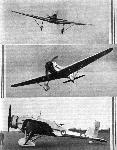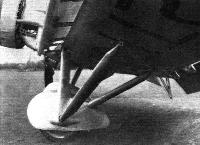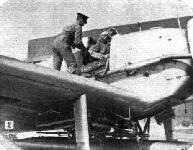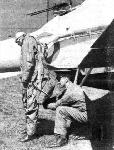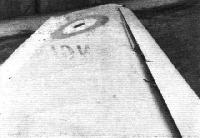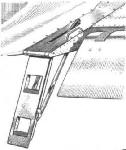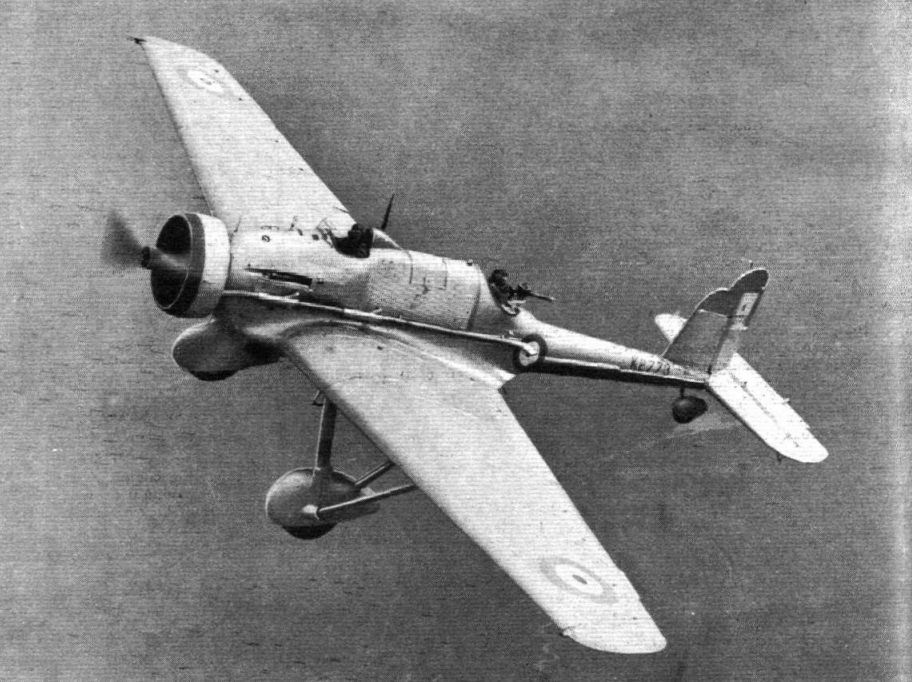
Flight, April 1935
A "G.P." HANDLEY PAGE
Latest Ideas Applied to a Military Aeroplane: Very Wide Speed Range Achieved: Extensive Equipment
OF all the different classes of aircraft used by the fighting services none places greater demands on the aircraft designer and constructor than does that known as the "General Purpose" class. Having to be applicable to a very wide range of duties, and being required to carry very extensive equipment, the type must still possess good performance, high fighting qualities such as view, field of fire, and manoeuvrability, and ability to operate from all manner of aerodromes, good, bad and indifferent. Long range is required of some of the duties for which the "G.P." machine is used, so that aerodynamic efficiency is an important consideration if the fuel consumed on a long flight is not to reduce the military load unduly.
In the H.P.47 General Purpose aeroplane the Handley Page designers have incorporated everything which modern science can suggest as an aid to aerodynamic, structural and military efficiency. The machine is a low-wing monoplane of all-metal construction, and, in spite of the heavy loads to be carried and the extensive equipment to be installed, the size is remarkably small.
Readers of Flight will probably recollect that several years ago Handley Page, Ltd., designed and built a machine for a safety aircraft competition held in the United States. A wealthy American, Mr. Guggenheim, offered the prizes, and the Handley Page machine became known facetiously as the "Gugnunc." The competition rules were such as to place a premium on low rather than on high speed, and it was the low rather than the high end of the speed scale which was encouraged, a wide speed range being, as in all aircraft performances, regarded as a measure of efficiency. In the H.P.47 no attempt has been made to obtain extremely low minimum speed. Rather can it be said that, by reducing the wing area to that which will give the highest landing speed that can be tolerated for the particular functions for which the machine has been designed, a high maximum speed has been achieved. As the machine is a military type, no performance figures may be published, but it can be said that a very high maximum speed has been combined with a very wide speed range.
The aerodynamic features of the design which have made the wide speed range possible include the use of leading edge slots along the whole wing span, and slotted trailing edge flaps extending from the wing root fillets to the ailerons. The leading edge slots are automatic in action, opening when a certain angle of incidence is reached and closing again as soon as an angle corresponding to high speed has been attained. The slotted trailing edge flaps, on the other hand, are hydraulically operated by the pilot.
To improve the lateral control at or beyond the stall, Handley Page "Interceptors" are used. These consist in small surfaces placed just behind the automatic wing tip slots. Normally the interceptors lie flat against the upper wing surface, but when brought into action by a large movement of the aileron control the interceptor on the wing which is rising is brought into an approximately vertical position. The effect is to spoil the air flow over the wing tip, thereby reducing the lift and thus bringing the wing down.
Lateral control by the aid of interceptors has the advantage that adverse yawing moments are not set up, but in the H.P.47 yet another powerful control is provided by the peculiar arrangement of the tail surfaces, reference to our photographs will show that instead of being placed above the tail the fin and rudder are placed ahead of the tail plane. The advantage of this arrangement is that at large angles of incidence the rudder is not "blanketed" by the tail, and thus retains its effectiveness. Another feature of the design which probably helps materially in retaining rudder effectiveness is the narrowing-in of the fuselage cross-section aft of the gunner's cockpit. This has a military as well as an aerodynamic advantage in that the rear gunner's view and field of fire in a downward and rearward direction are greatly improved.
Almost the only modern aid to aerodynamic efficiency which is not incorporated in the H.P.47 is a retractable undercarriage. With petrol tanks in the wings, and with bomb racks under the wings, it would be a somewhat difficult matter to provide space in the interior of the wing for the wheels. Instead, each wheel is carried on a tripod consisting of the telescopic leg, the radius rod and the lateral bracing strut. The latter, incidentally, runs outward from the wheel instead of inward. This is, of course, done to leave the centre of the wing unobstructed for the dropping of the bombs. Each wheel is almost totally enclosed in a fairing to reduce drag. A castering tail wheel is fitted, so that, with the differentially operated wheel brakes, the machine is very manoeuvrable on the ground.
Of the military aspects of the H.P.47 it is possible to say but very little. The relatively small fuselage gives little indication, from an external inspection, of the extent of the equipment carried. The structure is such that the whole space inside is available, and one result is that no room is wasted and that the crew are not hampered in their movements.
The pilot, as in all single-engined military aircraft, is placed just aft of the engine. In the 47 this is a Bristol "Pegasus" enclosed in a cowling ring. The view from the front cockpit is good, and the fact that the wing is heavily tapered reduces the blind area diagonally downwards. The fuselage deck drops away at the back so that the rear gunner is well protected against draught, while a t the same time he obtains a good view and a free field of fire for his machine gun.
Altogether, the H.P.47 is a very interesting aeroplane, and it will afford valuable information concerning the use of full-span slots, slotted flaps, and interceptors on a high-performance machine. The experience thus gained should be applicable to many other types.
- Flight, April 1935
A "G.P." HANDLEY PAGE
Фотографии
-
Flight 1935-04 / Flight
Регистрационный номер: K2773 [16] READY FOR MARTLESHAM. Capt. Cordes flying the new Handley Page 47 (Bristol "Pegasus") General Purpose machine. From the angle of the rudder and the general attitude it would appear that the machine was, at that instant, side-slipping slightly towards the Handley Page "Heyford" from which a Flight photographer took the picture.
-
Aeroplane Monthly 1974-03 / Handley Page HP 47 /Press Debut/
Регистрационный номер: K2773 [16] -
Aeroplane Monthly 1974-03 / Handley Page HP 47 /Press Debut/
Регистрационный номер: K2773 [16] -
Flight 1935-06 / Flight
Регистрационный номер: K2773 [16] The Handley Page H.P.47 General Purpose monoplane (700 h.p. Bristol "Pegasus" engine).
-
Aeroplane Monthly 1974-03 / Handley Page HP 47 /Press Debut/
Регистрационный номер: K2773 [16] -
Aeroplane Monthly 1974-03 / Handley Page HP 47 /Press Debut/
Регистрационный номер: K2773 [16] -
Aeroplane Monthly 1985-06 / ??? - RAF Pageantry
Регистрационный номер: K2773 [16] The H.P.47 general purpose monoplane, powered by a 750 h.p. Pegasus III engine, being flown by Sqn Ldr E. G. Hilton.
-
Flight 1935-04 / Flight
Регистрационный номер: K2773 [16] These three striking Flight photographs of the new Handley Page H.P.47 General Purpose aeroplane show the clean aerodynamic design and small size, made possible by the utilisation to the fullest extent of leading-edge slots, slotted trailing edge flaps, and "interceptors" or "lift spoilers." The rear view, taken from a Handley Page "Heyford," shows the machine from an unusual angle. The engine fitted is a Bristol "Pegasus."
-
Flight 1935-07 / Flight
Регистрационный номер: K2773 [16] The Handley Page H.P.47 general purpose monoplane (Bristol "Pegasus") flying above the Saro "Cloud " amphibian (two Napier "Rapier" engines).
Другие самолёты на фотографии: Saunders-Roe Cloud / A.19 - Великобритания - 1930
-
Aeroplane Monthly 1986-10 / A.Lumsden, T.Heffernan - Probe Probare (29)
Регистрационный номер: K2773 [16] One of 18 production Sidestrands, J9770 was later converted to an Overstrand. Note the H.P. 47 taking off in the background.
Другие самолёты на фотографии: Boulton Paul Overstrand / P.75 - Великобритания - 1933
-
Flight 1935-04 / Flight
Регистрационный номер: K2773 [16] Slots and spats of the new G.P. Handley Page. Note the slightly curved rails on which the slots move. The leading edge slots are automatic in action.
-
Flight 1935-05 / Flight
Регистрационный номер: K2773 [16] A Martlesham pilot prepares to take up the Handley Page "G.P." for full-load trials.
-
Flight 1935-05 / Flight
Регистрационный номер: K2773 [16] A Martlesham pilot gets ready for a 20,000-foot full-load climb in the new Handley Page general-purpose monoplane. Note the aneroid strapped to his knee. Martlesham Heath, like two score other Royal Air Force stations, will be open to public inspection on Saturday.
-
Flight 1935-04 / Flight
Регистрационный номер: K2773 [16] The slotted trailing edge flap and the wing root fillet of the starboard wing. The step leading to the top of the wing folds up under the lower wing surface when not in use.
-
Flight 1935-04 / Flight
Регистрационный номер: K2773 [16] The unusual tail arrangement of the H.P.47 is well shown in these photographs. As the fin and rudder are ahead of the horizontal tail surfaces they are not "blanketed" at large angles of incidence. The picture on the right gives a good idea of the view and field of fire obtained by the rear gunner.
-
Flight 1935-04 / Flight
Регистрационный номер: K2773 [16] Powerful lateral control is obtained by fitting "interceptors" behind the wing-tip slots. The interceptor is here shown in the "up" position.
-
Flight 1935-07 / Flight
The footstep on the Handley-Page G.P. monoplane folds upwards when not in use.
- Фотографии







